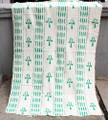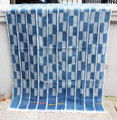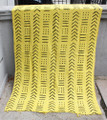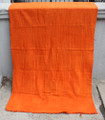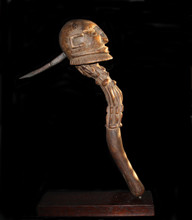 Loading... Please wait...
Loading... Please wait...- Home
- The Curators Gallery
- Dogon Tool: On Display at United Nations
- Home
- Spears/ Clubs/ Shields/Knives
- Dogon Tool: On Display at United Nations
Product Description
This item was on display at: "Indigenous Peoples and Food Sovereignty" An exhibition in recognition of Indigenous Peoples on the occasion of the Eleventh Session of the United Nations Permanent Forum on Indigenous Issues Visitor's Lobby, General Assembly Building, UN Headquarters, NYC May 8 - June 29, 2012
The Dogon people of Mali are among the oldest surviving African cultures despite the fact that throughout their existence more powerful neighbors have threatened them. For protection, until about 300 years ago the Dogon built their villages near or in the famous Bandiagara cliffs. They have thusly been nicknamed the Hill, Cliff and Mountain people. The Dogon realize that they are not the first inhabitants of the land that they now occupy. Their myths, legends, traditions and art retain the memories of their predecessors; the Tellum. During the 15th century the Dogon migrated from an area called Mande to the Cliff of Bandiaraga. It is here that the Dogon encountered the Tellum for the first time. Some Tellum were driven away while others choose to remain and join the Dogon. Both groups were basically agricultural farmers and knowledge of the environment was of the utmost importance. The soil on the rocky cliffs and sandy plains was very poor and had to constantly be built up and enriched. Permanent sources of water are rare on the cliffs, and rainfall was minimal. The Tellum used the cool dry caves among other things to store food. They used mud coils, mud bricks or stones to build granaries. Utilitarian objects such as wooden and clay pottery, baskets, wooden spoons, hoe like instruments, various tools, axes, grindstones and leather water bags were created and much needed. The Dogon learned how to survive under the trying conditions of the Cliffs from the Tellum. Not surprisingly Dogon and Tellum art are barely distinguishable from each other. The Dogon, cherishing their relationship, imposed Tellum figures on much of their creative works. Artistically, the Tellum were represented in a classic, simplified, elongated form, often with hands raised skyward. This tool is a wonderful example of functional African art. Africans take immense pride in their tribal histories, ancestors, and the adjoining unique motifs and symbols that are associated with them. A Dogon craftsman has taken a tool that normally consists of a plain handle and a simple blade and transformed it into an object that transcends its primary function for field and woodwork into one that deserves art gallery exposure. The top portion of this tool features the head of the fabled male Dogon ancestor Nommo. A newer replacement blade has been secured to the back to ensure continued usage. The beautiful hard wood grain continues down the handle where classic Tellum figures have been carefully carved. This tool has a sleek, sexy curved appealing look and a sturdy feel to it. The brown wooden display stand is included with purchase!
Please click photo for enlargement!
Dimensions: The entire piece measures 14 1/2 inches tall. The head is 4 inches deep x 2 1/2 inches across. The Dogon motif travels down the handle 5 1/2 inches. The blade is 4 inches long. The dark brown wooden base measures 9 1/4 inches long x 3 1/2 inches deep x 1 inch thick.
Sold
Any QUESTIONS please leave a message here at Contact Us!



